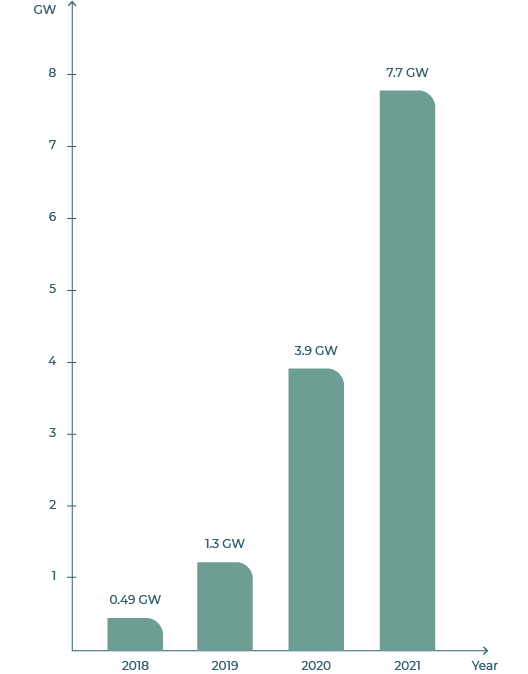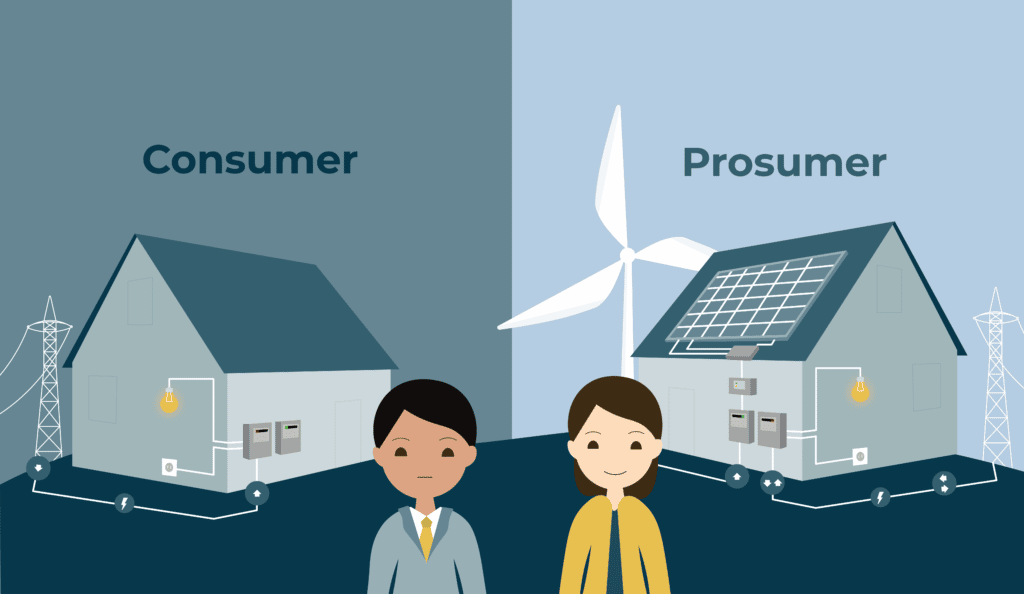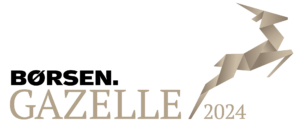Looking at the renewable industry, many exciting movements are emerging. Hybridization, digitalization, and green energy utilization, just to name a few. In this article, we guide you into what trends you should have on your radar in the coming years.
The renewable energy sector is evolving at an accelerating speed, and the lookout for a renewable future is no longer just an ambition – it is becoming a reality.
The steep climb in renewable capacity has gathered speed in recent years. For wind, the global installed wind capacity rose from 745 GW in 2020 to 837 GW in 2021 – an increase of more than 12 percent in just one year.
Looking at solar PV, the development is even more significant. In April 2022, worldwide solar PV installations reached one terawatt.
With the rise in wind and solar PV capacity, new challenges emerge that foster new solutions and ways to secure the movement towards combatting climate change. In this article, we explore four current trends that we think will shape the renewable future in the years to come.
1 Growing interest in hybrid renewable plants
For more than a decade, SCADA International has delivered control solutions for mixed parks – e.g., combining different unit types in one park – and the current market outlook suggests a growing interest in mixed parks. There is especially an interest in hybrid parks, where you combine different technologies, such as wind, solar PV, batteries, and PtX plants.
According to Renewable Energy World, the interest is mainly directed toward hybrid parks of solar PV paired with batteries, but many different combinations are seen in the renewable landscape.
One of the reasons that hybrid plants are on the rise is that they often bring about construction cost savings, especially in terms of grid infrastructure and grid cables. In Germany, hybridization is actually a condition in the so-called “innovation tenders” as it encourages developers to build plants that can bring more stability to the grid.
Furthermore, hybrid plants can act more flexibly due to the many configuration options available. This makes them very suitable for engaging with electricity markets and valuable for the ancillary service markets.
However, with more flexibility follows increased complexity as the connected units consist of different technology and communication systems that need to be integrated. In addition, controlling the power output will likewise become more complex as more units are added to the system. Knowledge of the different units and the overall system is thus vital in a hybrid plant setup.
2 Storage solutions as the inevitable revolution

When speaking of flexibility, energy storage systems cannot be left without mention.
As you may know, the electricity grid must be stable at all times, meaning that power production and demand must be balanced.
With conventional power resources such as coal, gas, and oil, balancing the power is easy, as you can quickly turn the power production on and off depending on demand. But with fluctuating power resources like renewables, production happens according to nature rather than consumer needs, removing the flexibility of system control.
Today, when renewable production exceeds the demand, renewable power units such as wind turbines are curtailed, ensuring a balanced grid.
However, with energy storage systems, you can restore system flexibility by comprising power, often in the form of batteries, but also heat, hydrogen, and other forms of energy.
When surplus power is reserved rather than curtailed, not only is the renewable energy better utilized, but it also provides better conditions for managing fluctuations, as the reserved energy can be released in times of high demand and low production and again stored when the production exceeds demand.
This type of flexibility opens the door to the mass increase of renewable energy production that is already happening. And that is also why energy storage is predicted to be a game-changer.
According to a report by McKinsey & Company, the deployment of long-duration energy storage could result in the avoidance of 1.5 to 2.3 gigatons of CO2 equivalent per year in 2040. This is around 10 to 15 percent of today’s power sector emissions.
To reach this mark, it is evident that policies regarding energy storage are needed to lay the groundwork for market development. Currently, more than 25 countries have adopted a PtX (Power-to-X) strategy, including Denmark, where several projects are already launched.
Thus, energy storage will undoubtedly be something to keep an eye on for the next many years.
3 Solar power on the rise

Talking about the renewable industry, solar power must not be forgotten. Following the predictions of the International Energy Agency (IEA), solar power is expected to account for 60% of the increase in global renewable capacity in 2022.
The power from the sun can be obtained in many ways, whereas solar photovoltaic systems – solar PV – are the most common.
Looking at the market for solar PV, Asia is by far the biggest market, with 439 GW of installed capacity by 2020.
Although, other markets are also emerging. At SCADA International, we have closely followed Poland’s growing solar PV development in recent years. Here, the installed capacity has doubled from 2020 to 2021 and is forecasted to grow even more significantly in the coming years.
One of the reasons solar power is on the rise is due to its cost competitiveness. Over the last years, the CAPEX costs of solar PV developments have dropped significantly – especially compared to onshore wind.
Additionally, despite the rising costs of raw materials, the IEA expects a rise in PV installations in the following years with even an increase in solar power’s cost advantage.
4 The fascinating expansion of prosumer markets and local energy communities

Another way the energy market is revolutionizing is the expansion of prosumer markets and consumer engagement.
To a large extent, the green movement is fostered by consumers’ desire to ensure a better future for the next generations. And in that, renewables play a big part.
According to a recent study from Mintel, 82% believe investments in renewable energy have a high to moderate impact on solving environmental issues.
Taking it further, the study also shows that many consumers are interested in investing in renewables themselves – by, e.g., purchasing solar panels for their homes.
The prosumer energy market, where consumers both use and produce energy, is growing.
Combined with the change in consumer attitudes, the prosumer market growth is also said to be caused by the movement towards decentralized power systems. These systems provide greater flexibility, especially in remote areas, and fewer investments in grid infrastructure for system operators, as the power produced is consumed locally.
Prosumers are not only private consumers but often local communities that pool their investments.
With these decentralized local communities, so-called microgrids are created. Although upfront investments might be high, prosumers can expect a drop in their electricity bill and sell it to system operators at a low price.
And with savings across the value chain, the movement “away from a centralized energy system towards a more geographically distributed, prosumer-centric model benefits all parties,” as Research Scientist Antti Keski-Koukkari explains.










